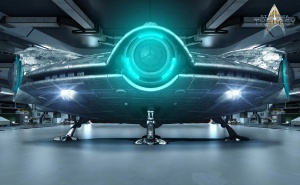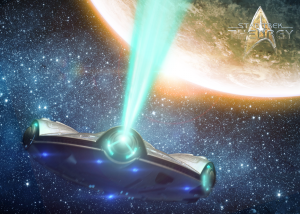Overseer-class Research Saucer: Difference between revisions
From Star Trek: Theurgy Wiki
mNo edit summary |
Auctor Lucan (talk | contribs) No edit summary |
||
| Line 1: | Line 1: | ||
{| class="wikitable floatright" style="width: 20%; background: #252525; color: white;" | {| class="wikitable floatright" style="width: 20%; background: #252525; color: white;" | ||
| colspan="2" | [[File: | | colspan="2" | [[File:KRK-9009 Overseer-class Research Saucer Detail.jpg|300px]] | ||
|- | |- | ||
| Name: | | Name: | ||
| Overseer | | Overseer-class Research Saucer | ||
|- | |- | ||
| Model: | | Model: | ||
| Line 102: | Line 102: | ||
* Rations (2mos) | * Rations (2mos) | ||
|- | |- | ||
| colspan="2" | [[File: | | colspan="2" | [[File:KRK-9009-Overseer-class-Research-Saucer.png|300px]] | ||
|} | |} | ||
Overseers were a sturdy class of survey vessels built for undetected observation. The KRK-9009 series was built specifically to observe pre-contact species on class H, M, O, and P planets. During the Sheromi contact with Asurians, many motherships still held MK IV versions of the ships despite their decommissioning. The Asurians now fly a handful of these saucers for the purpose of pirating and battle. | Overseers were a sturdy class of survey vessels built for undetected observation. The KRK-9009 series was built specifically to observe pre-contact species on class H, M, O, and P planets. During the Sheromi contact with Asurians, many motherships still held MK IV versions of the ships despite their decommissioning. The Asurians now fly a handful of these saucers for the purpose of pirating and battle. | ||
Revision as of 11:50, 8 November 2016
Overseers were a sturdy class of survey vessels built for undetected observation. The KRK-9009 series was built specifically to observe pre-contact species on class H, M, O, and P planets. During the Sheromi contact with Asurians, many motherships still held MK IV versions of the ships despite their decommissioning. The Asurians now fly a handful of these saucers for the purpose of pirating and battle.
The Overseer class is infamous for having started the pop-culture fad of 'flying saucers' on Earth. Sheromi used the MK IV saucers for observing humans and consequently left an imprint of their ships in human culture. A handful of younger cultures also share the same cultural phenomenon for the same reasons.
Production History
The Sheromi employ a number of research and exploration vessels in their never-ending mission to continue what the Preservers started, but dependable spacecraft were scarce. Their older ships did not often survive the transition from space to an atmosphere, and if they did, their observational ships would sometimes be spotted, which would make much of their research invalid. In civilizations with primitive weaponry and aircraft, they found that their older ships could not leave fast enough. Often the ship would be damaged, the sensitive, fragile instruments inside would be damaged, or they'd lose the ship altogether. The Overseer class arose from the need for a quiet, stealthy scientific vessel that would remain largely untouched by the kinetic weaponry of most primitive alien civilizations.
The Overseer class made it's first debut in 1888 as a purely experimental prototype, deployed on a select few pre-sentient planets for the purpose of demonstrating the effectiveness of the new craft. The design proved highly popular, with the only flaws being the high power consumption of the engines and the unusual shape of the craft. Soon, Sheromi Motherships employed the use of Overseer class saucers almost universally for the purpose of observation. Their cloaking systems made them the favored ship of researchers, as it allowed them to observe without being observed. The cloaking system was deemed so important that all ships regardless of make received almost continual updates until 2045. Ships with an out-of-date system are rare--saucers with no system are even rarer.
Later developments in 1960 and 1985 led to the development of the MK II and MK III Overseers. The MK II Overseer had its RF Cavity Thruster engine replaced with a Gravitic displacement engine, giving the Overseer class its trademark maneuverability and decreasing the amount of power consumed by the engine at any given time. The MK II was also the first class to use the liquid alloy known as Kkrek.
The MK III received an impulse engine upgrade and was also the first class with a tractor beam tuned specifically for organic matter. As the Sheromi studied more and more with sentient beings, it became important to develop some means of picking samples, hence the tractor beam.
The MK IV and the final upgrade before it's eventual decommissioning had a basic weapons system to take down potential pursuers and a complete overhaul of the crude navigational beam that previous makes had. Now each ship came equipped with graviton beams of a caliber not yet manufactured by Starfleet. Another minor addition was the use of a gentle blue floodlight that activated whenever the short range organic matter (SROM) beam activated, as humans didn't respond to pheromones as well as they did strange lights. This was in addition to the pheromone emitters that all previous makes had. The light could be removed or disabled as needed.
Exterior Features
The Overseer class carries a few features considered new or unusual compared to Federation starships, since the Sheromi are not a part of the Federation and do not have contact with them.
Kkrek Alloy
Kkrek is a thin, silver-translucent, non-Newtonian liquid at room temperature, a mixture of both natural and lab-created elements. It is a super-hydrophobic alloy that does not bond easily in the presence of other elements. It hardens permanently when exposed to high heats. The surface of heated Kkrek is extremely smooth and reduces friction to near-zero. It can sometimes feel chilly to the touch.
Kkrek alloy coating deteriorates over the span of several centuries, though hard strikes to the surface of the alloy can sometimes break the coating, leaving the surface below open to damage. Although rain and wind slide right off the alloy, hail can sometimes cause hairpin cracks that will reduce the coating's overall effectiveness, and large meteors can sometimes tear off chunks of coating all together.
It is possible to strip and re-coat a saucer, but it takes a few days to complete.
Quadruple Deflector Dishes
Each Saucer is outfitted with four deflector dishes across the widest part of the saucer. Each deflector dish has the same capabilities as all the others. There are virtually no differences in a freshly-manufactured Saucer's deflector dishes.
It is possible to operate one dish at a time, or to sync all dishes. more stuff to write here
Kinetic Shielding
these babies do stuff
SROM Beam
this bad boy lifts stuff
Entry Ramp
In addition to teleportation technology, Saucers all use an entry/exit ramp located on the underside of their hull. When on ground, this ramp can be used to load people and goods on and off. The ramp also slides aside to allow in persons or objects being 'abducted'


